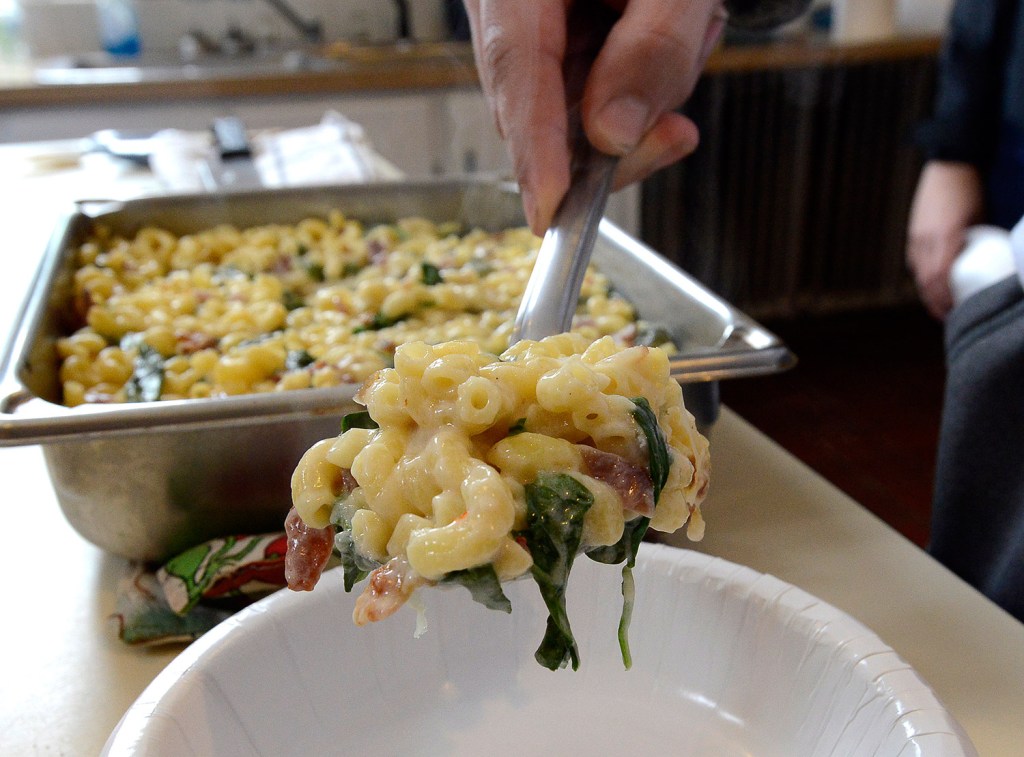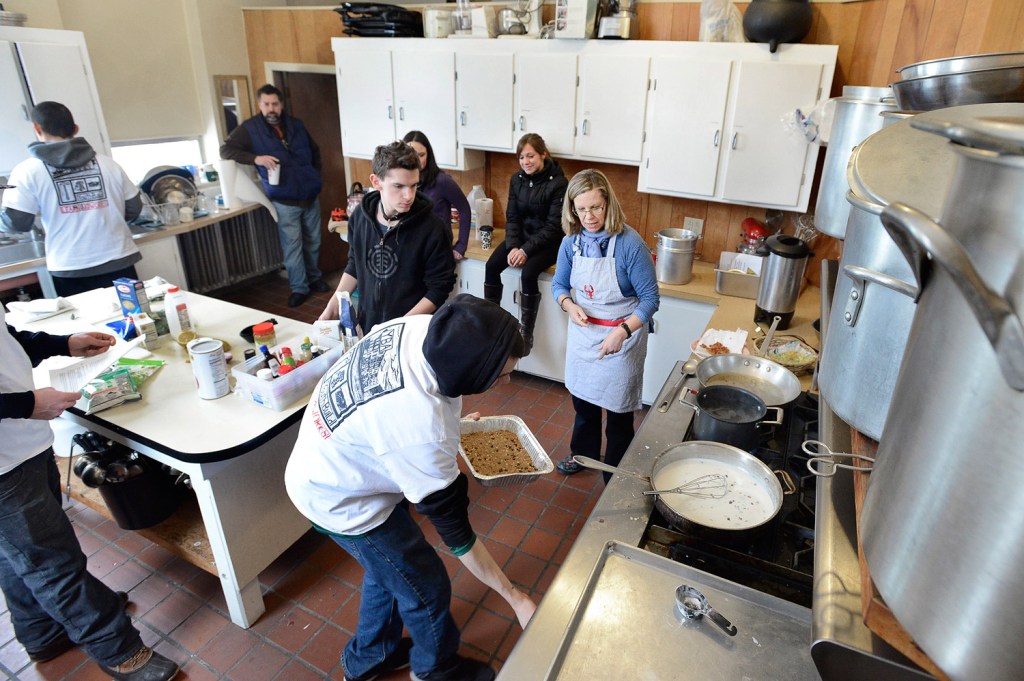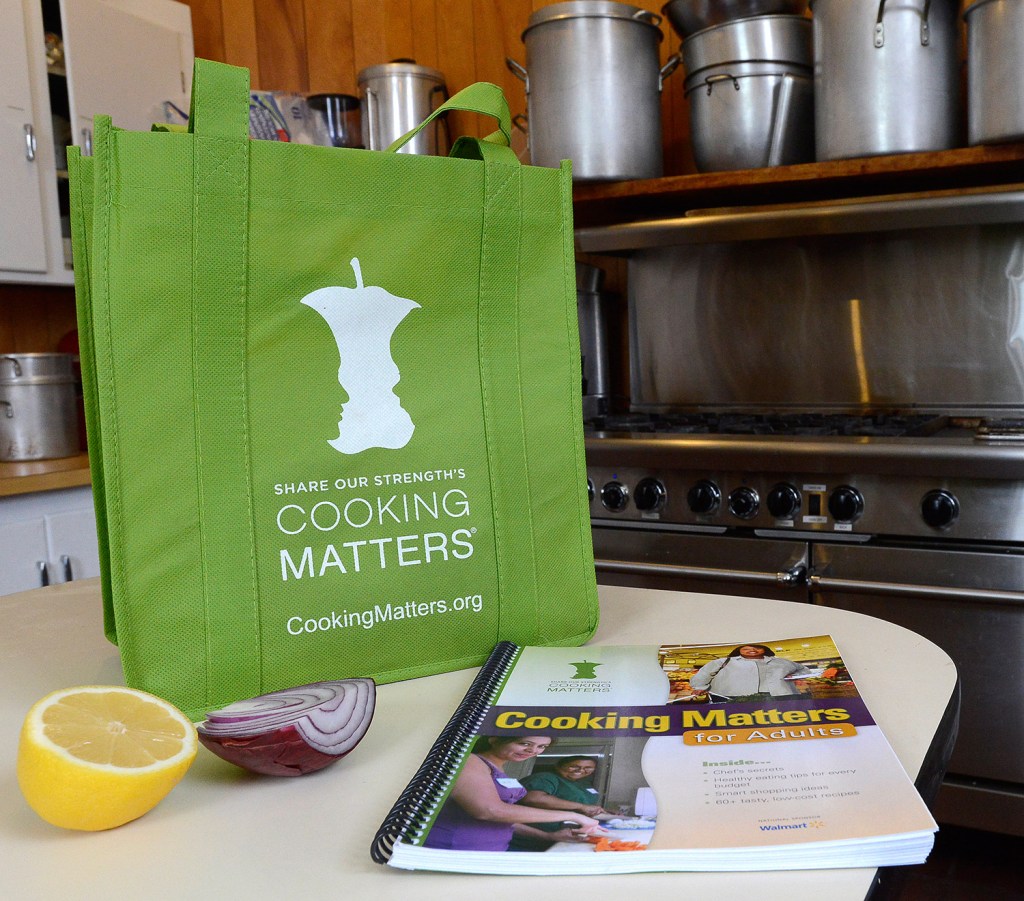On a bright, cold Thursday morning in early January, I stood in the parish hall kitchen of St. Louis Roman Catholic Church on Portland’s West End not knowing quite what to expect. The worn but well-equipped kitchen is where students from Portland’s LearningWorks organization participate in Cooking Matters, a hands-on, food and nutrition education program administered by Good Shepherd Food-Bank. I had volunteered to teach a six-week class. I thought I was prepared, with recipes, ingredients and a well-thumbed curriculum guide, but first, I had to figure out the kitchen.
The door to the parish hall creaked open and six teens shuffled in with two teachers; the kids – who have dropped out of high school and are working to get their GEDs, on vocational training and/or college prep – huddled on a sofa next to an electric fireplace to warm up.
My teaching partner Brenna Albert, a dietitian who works for Healthy Portland, got things started by talking about MyPlate – the federal government’s latest update of the food pyramid. Meanwhile, I fiddled with the knobs on the big commercial stove, finally realizing the burners wouldn’t light until the gas was turned on at the source, a lever on the pipe coming out of the floor.
As a former caterer and restaurant owner, I’ve cooked in lots of wonky kitchens. I’ve taught lots of cooking classes, too, so I’m not sure why I was so anxious about this one. Perhaps because the stakes seemed much higher than teaching an hors d’oeuvres class at Williams Sonoma. I had signed on to teach the Learning Works students skills that had the potential to change their lives. Also, I wasn’t sure I was up to the task – often these classes are taught by chefs. Would the kids feel I had anything to offer them?
FEEDING A COMMUNITY NEED
A national program launched in 1993, Cooking Matters is part of Share Our Strength’s No Kid Hungry initiative to end childhood hunger in America. Its mission is to give low-income families, adults and kids the information and tools to eat healthfully on a budget. It works through local nonprofits, which partner with government agencies and grocery stores. Cooking Matters Maine was founded in 2010, and has grown steadily from just eight classes the first year to 200 last year.
Each student and instructor gets a Cooking Matters cookbook, which instructors can use or not, as long as what they cook is healthy, low-cost, and uses readily available ingredients.
For my first class, I’d planned pizza with prepared whole-wheat dough, homemade tomato sauce (the sauce gets a nutritional boost from grated carrots) and healthy toppings, pizza having been recommended as a good way to break the ice. And for dessert, apple and pear crisp. The kids each had a knife and cutting board, ready for the first lesson – how to chop an onion. I rooted around in the kitchen’s crowded cabinets to locate a grater, but couldn’t find one, so demonstrated how to slice and dice the carrots, handing off the task to a couple of the kids who had quickly picked up how to safely handle a knife. (A few had to be shown that holding half an onion in your hand and slicing down toward your palm was not, ahem, a good idea.)
The kids soon got into customizing their pizzas with turkey sausage, turkey pepperoni and bell peppers. Most turned up their noses at the mushrooms, spinach and feta cheese. They did get creative with shapes, and not necessarily on purpose. Stretching the dough was a challenge, and by the time the pizzas were ready to be transferred to a sheet pan, some were so loaded with toppings they had to be scooped off the counters. Magnificently messy, the various-shaped personal pizzas went into the oven. As they baked, a few of the kids energetically cleaned up the flour-strewn kitchen, and a few retreated to the couch.
We ate our creations for lunch – my pizza topped with ingredients they had rejected. Although eating together is part of the program’s mission, I hesitated to join the teens at the table. Although we had worked closely together in the kitchen, it felt like crowding them. They’re teenagers, I thought to myself, give them their space.
After the first class, my nervousness faded. For the most part, the kids were a responsive, respectful bunch, eager to learn and good about taking direction. Most were boys, a few of whom were expressive and chatty; others hung back and needed to be nudged to join in. I knew some of them likely had difficult home lives, were couch-surfing, living on their own or had been in trouble with the law, but I didn’t know any details, and I didn’t care. All that mattered to me was that they were there in that kitchen, hopefully learning something useful, and just maybe having a good time.
That first class we ran out of time to make the fruit crisp – a favorite recipe from my mother. So the following week, we started with the dessert. The kids learned to slice apples and to use their hands to mix the crumbly topping. Using their (clean) hands as a tool was something I mentioned – and recommended – often during the course. Their hands tossed cauliflower and broccoli with olive oil, salt and pepper before roasting; coated strips of haddock with cornmeal to fry for fish tacos; and, as a special treat, shaped chocolate ganache into truffles just before Valentine’s Day.
Because I usually had a different group of teens each week, the classes couldn’t build on one another. Class by class, we roasted chicken and made vegetable lasagna, macaroni and cheese with bacon and kale, and chicken “diablo.” They devoured everything.
Most of the teens were good about trying new things. They weren’t sure about the shredded cabbage on the fish tacos, but eventually agreed the crunch was perfect with the soft fish. The mushrooms that were ignored when we made the pizzas were (mostly) enjoyed in the lasagna. I also showed the kids how to make a couple of easy, reasonably nutritious treats: chocolate-banana cake and peanut-butter chocolate chip oatmeal bars (a recipe I made healthier with whole wheat flour and less sugar).
EMPOWERING KIDS AT A CROSSROADS
Cooking Matters works with families, teens, children, adults, parents and childcare workers. I asked for LearningWorks students because I hoped to make an impact on kids at a crossroads. I wanted to show them how easy and fulfilling it could be to skip Taco Bell and make their own tacos. I wanted them to feel good about their kitchen skills and to see cooking – even on a tight budget – as a source of pride and fun.
I haven’t faced anywhere near the same challenges as most of these kids have, but in my own tumultuous younger years, cooking offered solace and self-esteem. It’s had the same effect on my 21-year-old son, who has his share of struggles, but shines in the kitchen, both in the restaurant where he works and at home.
He joined me for two of the classes, making me smile when he told the kids, “There are just two things you need to know about working in a restaurant kitchen. One, show up on time. Two, say ‘Yes chef.'” His knife skills, because he uses them daily, are better than mine, which helped immensely when the class cut up piles of vegetables for lasagna and tacos. The boys, especially, seemed to appreciate learning from someone they could identify with, and I loved hearing them laugh as my son taught them to flip vegetables that were sautéing in a skillet.
When the six weeks were over, I wondered: Had I made a difference?
One of the kids’ teachers told me that attendance was higher at school on the days the students were scheduled for my cooking class. Next I went straight to the source, asking three of my regulars what they’d learned.
James Rivera, 19, of Westbrook has worked at Boda in Portland and KFC and wants to be a chef. “I learned how to cut things the right way,” he said, “and about new ingredients.” Fellow Westbrook resident Jordan Buck, 18, a soft-spoken girl who often worked quietly at my side, said she also improved her knife skills (her favorite recipe, she told me, was the chocolate-banana cake. Find the recipe below). Bailey Hand of South Portland, 17, said he’d tried new foods, made the chicken diablo at home, and now reads labels at the grocery store. “It made me think twice about what I’m putting in my body,” he said.
A few of the kids told me they were interested in baking. Would I consider teaching another class? Absolutely! I’ve heard teachers say that they learn more than their students do. In this case, it was definitely true.
RECIPES
VEGETABLE LASAGNA
Serves 6-8
8 ounces uncooked whole-wheat lasagna noodles
4 tablespoons canola oil
1 onion, finely chopped
¾-1 pound ground turkey (dark meat if available)
5 cloves garlic, finely chopped
Salt and pepper
8 ounces mushrooms, chopped
1 medium zucchini, chopped
1 (10-ounce box) frozen chopped spinach, thawed and squeezed dry
8 ounces part-skim ricotta cheese
8 ounces part-skim mozzarella cheese, grated
2½ ounces grated Parmesan cheese
6 cups jarred marinara sauce
Cook the lasagna noodles according to package directions. Drain and rinse with cold water to keep them from sticking to each other.
Preheat the oven to 350 degrees.
Heat 2 tablespoons of the oil in a large skillet. Add the onion and sauté until softened but not brown, 5 to 8 minutes. Add the ground turkey and garlic; cook until the turkey is no longer pink, 10 to 12 minutes. Season with salt and pepper, remove from the skillet and set aside.
In the same (now empty) skillet, heat the remaining 2 tablespoons of oil. Add the mushrooms and cook, stirring, for 2 minutes. Add the zucchini and cook until the vegetables are soft, 8 to 10 minutes.
Transfer the vegetables to a large bowl and add the chopped spinach and ricotta cheese. Season with salt and pepper and mix well.
Combine the mozzarella and Parmesan cheeses in a medium bowl.
Pour about ¼ cup marinara sauce into the bottom of a 9-by-13-inch baking pan. Add a layer of lasagna noodles, followed by a layer of the cooked turkey, then the vegetable/ricotta cheese mixture, and last the combined mozzarella and Parmesan. Continue layering in the same order until pan is filled, finishing with a layer of the cheeses.
Bake for 45 minutes to 1 hour until browned and bubbly.
CHOCOLATE-BANANA CAKE
Serves 9
3 large, ripe bananas, mashed
1/2 cup granulated sugar
1/3 cup canola oil
1/3 cup lowfat milk
1 teaspoon vanilla extract
1¼ cups all-purpose flour
1/2 cup cocoa powder
1 teaspoon baking powder
¼ teaspoon salt
Cooking spray
Preheat the oven to 350 degrees and spray a 9-inch square pan with cooking spray.
In the bowl of an electric mixer on medium speed, blend the bananas with the sugar, oil, milk and vanilla until well combined.
Add the flour, cocoa powder, baking powder and salt. Mix on medium speed just until the dry ingredients are incorporated; do not overmix.
Spread the batter evenly in the prepared pan. Bake for 25-30 minutes or until a toothpick inserted in the center of the cake comes out clean.
Cool completely on a wire rack before frosting.
FROSTING:
¼ cup (2 ounces) low-fat cream cheese, softened
4 tablespoons butter, softened
1½ cups confectioners’ sugar
½ cup cocoa powder
½ teaspoon vanilla extract
3-4 tablespoons lowfat milk
In the bowl of an electric mixer, beat the cream cheese and butter until smooth. Add the confectioners’ sugar and cocoa powder; mix until well blended.
Add the vanilla, then gradually add the milk until the frosting is a spreadable consistency.
Frost the cooled cake. Store any leftover cake in the refrigerator.
Send questions/comments to the editors.






